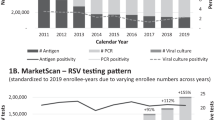Abstract
Objective: To enhance HIV surveillance within a non-nominal provincial testing system.
Methods: Confirmatory HIV tests from a provincial laboratory were analyzed during 1995 and 1996. Enhancements included elimination of repeat positive tests for the same individual using automated matching of non-nominal identifiers and nurse call-back of health care providers, completion of missing information through call-back and connection of providers with resources for patient care.
Results: Forty-seven percent of 2,683 reactive HIV tests were identified as duplicates for the same individual, meaning that 1,401 people tested positive for the first time. From laboratory test data to enhanced unduplicated data after call-back, the proportion of tests for which risk and ethnic information was unknown dropped from 37% to 11% and from 64% to 18% respectively (p<0.0001).
Conclusions: Enhanced non-nominal surveillance for HIV is a practical means of marrying the needs of public health for epidemiological information and the rights of patients to privacy.
Résumé
Objectif: Améliorer la surveillance du VIH à l’intérieur d’un système de dépistage provincial non-nominal.
Méthodes: Les tests de confirmation du VIH provenant du laboratoire provincial furent analysés utilisant un système de surveillance amélioré en 1995 et 1996. Les doublons furent éliminés à l’aide d’un système informatique jumelant les données non-nominales et d’une infirmière appelant les travailleurs de la santé. Lors des appels, l’infirmière recueillait certains renseignements manquants et informait quant aux ressources disponibles pour les patients.
Résultats: Quarante-sept pour cent des 2 683 tests positifs au VIH furent identifiés comme doublons provenant de mêmes individus. Des données de laboratoires brutes aux données améliorées, la proportion des tests pour lesquels les facteurs de risque et l’origine ethnique étaient inconnus a baissé de 37% à 11% et de 64% à 18% respectivement (p<0,0001).
Conclusion: La surveillance non-nominale du VIH est un moyen pratique de répondre aux besoins de données épidémiologiques de la santé publique et du respect des droits à la confidentialité des individus.
Similar content being viewed by others
References
Kassler WJ, Meriwether RA, Klimko TB, et al. Eliminating access to anonymous HIV antibody testing in North Carolina: Effects on HIV testing and partner notification. J Acquired Immune Deficiency Syndromes and Human Retrovirology 1997;14:281–89.
Tindall B, Barker S, Donovan B, et al. Characteristics of the acute clinical illness associated with human immunodeficiency virus infection. Arch Intern Med 1988;148:945–49.
Patrick DM, Strathdee SA, Archibald CP, et al. Determinants of HIV seroconversion in injection drug users during a period of rising prevalence in Vancouver. Int J STD AIDS 1997;8:437–45.
Strathdee SA, Patrick DM, Currie S, et al. Needle exchange is not enough: Lessons from the Vancouver injection drug use study. AIDS 1997;11:F59–F65.
Gertig D, Crofts N, Stevenson E, Breschkin A. The epidemiology of HIV-1 infection in Victoria. Med J Aust 1993;158(Jan 4):17–20.
Palmer R, Major C, Brown D, et al. A decade of lab oratory-based HIV surveillance. Vancouver, XI International Conference on AIDS, 1996. Abstract Mo.C. 1546.
Centers for Disease Control. Evaluation of HIV case surveillance through the use of non-name unique identifiers–Maryland and Texas. MMWR 1998;46(52&53):1254–71.
Sutherland D, Archibald CP, Houston S, et al. HIV testing behaviour of Canadians. Vancouver, XI International Conference on AIDS, 1996. Abstract Mo.C.210.
McDonald A, Kaldor JM. Assessment of patient report of exposure to HIV in Australia. Vancouver, XI International Conference on AIDS, 1996. Abstract Mo.C.1540.
Stevenson EM, Thompson SC, Crofts N. HIV testing and policy change, an analysis based on statewide HIV testing data, 1994–1995. Vancouver, XI International Conference on AIDS, 1996. Abstract Mo.C.212.
Centers for Disease Control. Update: HIV counseling and testing using rapid tests–United States, 1995. MMWR 1998;47(11):211–15.
Author information
Authors and Affiliations
Corresponding author
Additional information
This work was supported by a grant from the Bureau of HIV and STD, Laboratory Centre for Disease Control, Health Canada.
Rights and permissions
About this article
Cite this article
Patrick, D.M., Rekart, M.L., Cook, D. et al. Non-Nominal HIV Surveillance: Preserving Privacy While Tracking an Epidemic. Can J Public Health 90, 164–167 (1999). https://doi.org/10.1007/BF03404499
Received:
Accepted:
Published:
Issue Date:
DOI: https://doi.org/10.1007/BF03404499




